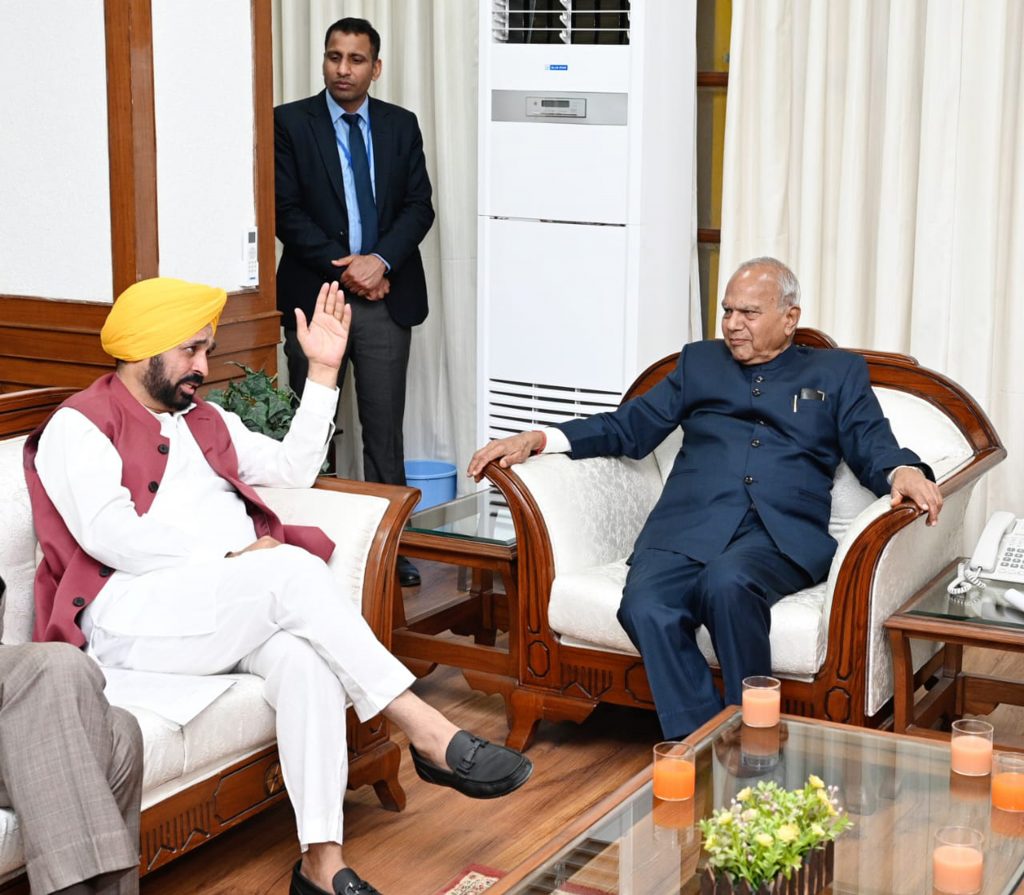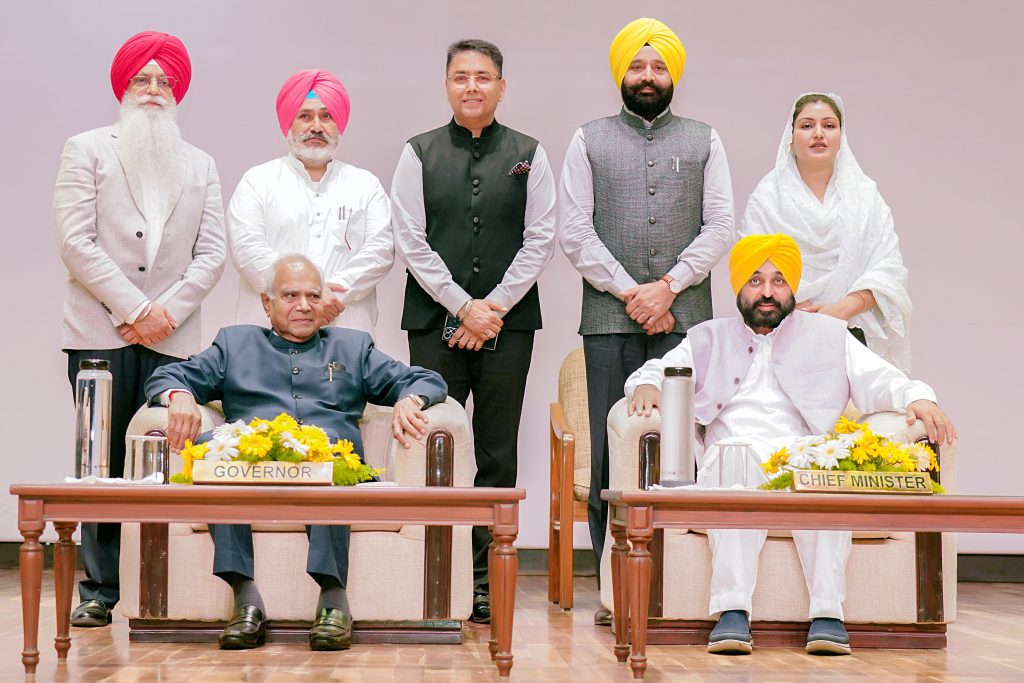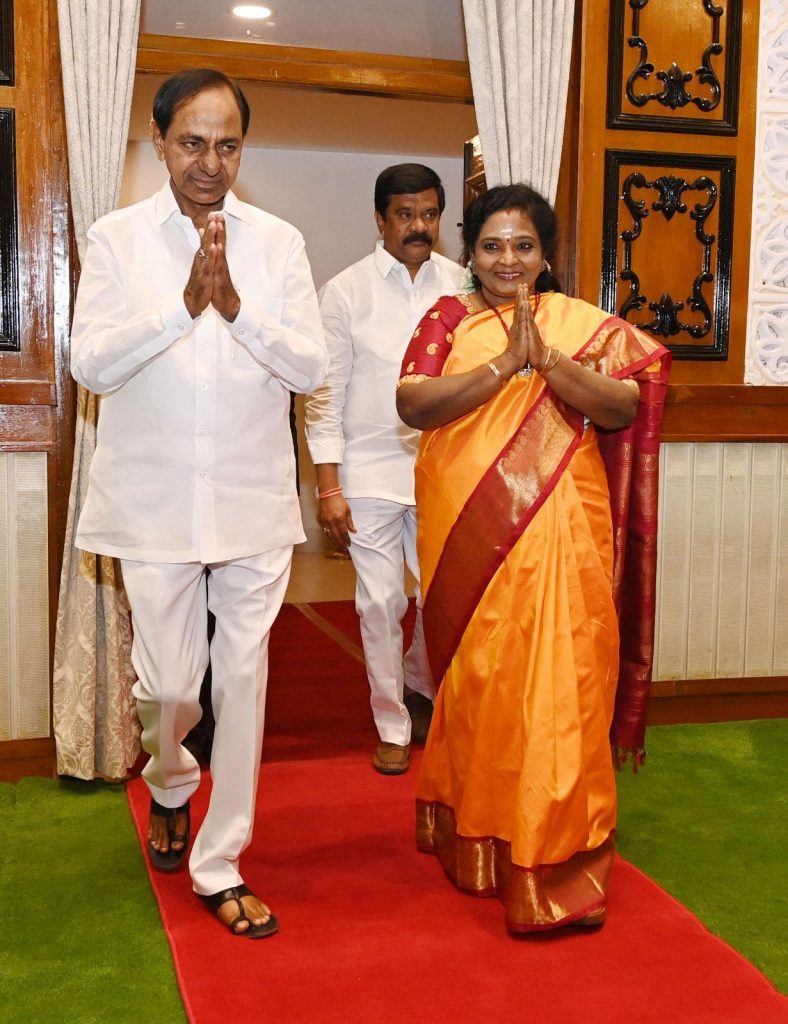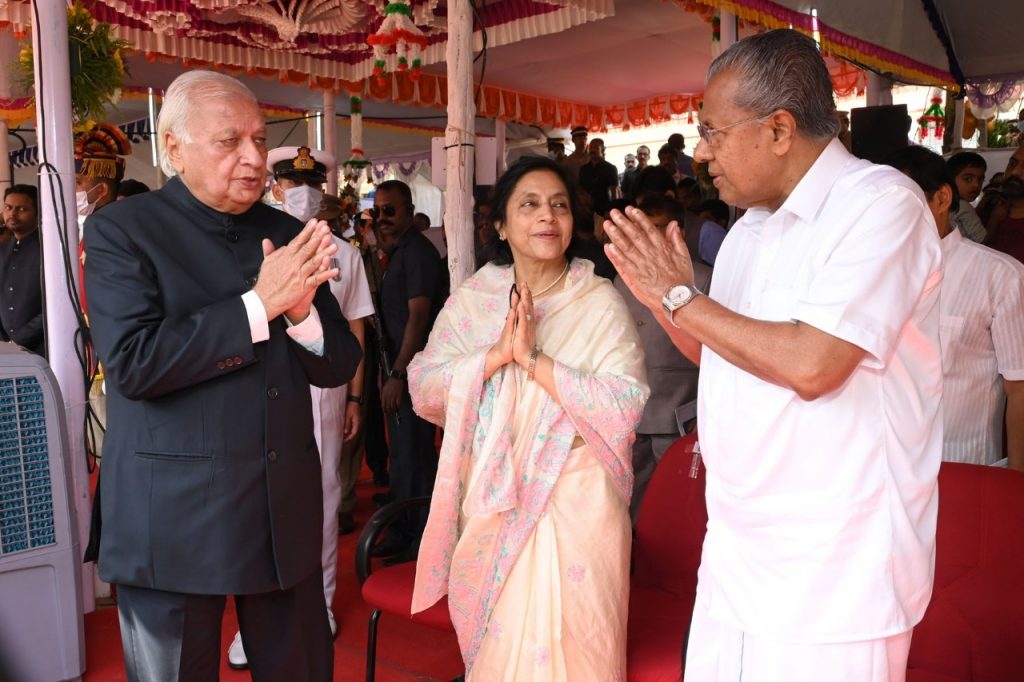Racing to the Bottom
The ugly spat between Punjab CM Mann and Governor Banwarilal Purohit has once again exposed the fragile fault lines between the two constitutional entities, writes Kumkum Chadha
When the apex court cautioned policy makers not to let the level of discourse degenerate into a “race to the bottom”, it was a reflection on the dismal state of affairs in the country.
The Supreme Court was adjudicating a confrontation between a Chief Minister and a Governor over summoning the Budget session of a state Assembly.
The state in question: Punjab

The dramatis personae: Governor Banwarilal Purohit and Chief Minister Bhagwant Singh Mann.
The Court was hearing Punjab Government’s petition against Purohit’s refusal to summon the Assembly for the Budget session from March 3.
Amid a slew of arguments, what however, stood out were the observations by the Court on the need for “mature statesmanship” and “decorum” in communications between Chief Ministers and Governors: “Political differences in a democratic polity are acceptable and have to be worked out with a sense of sobriety and maturity without allowing the discourse to degenerate to become a race to the bottom. Unless these principles were to be born in mind, the effective implementation of the constitutional values is liable to be placed in jeopardy,” the Bench said.
While doing so, the Court criticised the role of both Mann and Purohit while observing that they were both “derelict” in discharging their duties. If Mann was rapped for his failure to furnish information to the Governor on certain issues, equally it disapproved of Purohit’s refusal to summon the Assembly session.
Reminding the Governor that he was “duty bound” to summon the House, this power not being discretionary, the Court did record that the “the tone and tenor of the tweet and the letter by the chief minister left much to be desired”.

Mann had earlier refused to answer the Governor’s queries and tweeted that he was not accountable to the Governor: “According to the Constitution, I and my government are accountable to 3 crore Punjabis and not any governor appointed by the central government. Treat this as my reply,” the Chief Minister had tweeted in Punjabi.
“Intemperate” is the word the apex Court had used while referring to the language Mann had used both in his letter to the Governor and his tweet.
Courts apart, a political slugfest between the Governor and the Chief Minister had played out in the Assembly too.
It was the first day of the Budget session wherein there were heated exchanges between legislators and the Governor.
And this time around it was not the Chief Minister or his Party but the Leader of Opposition, Partap Singh Bajwa, who objected to the Governor referring to the state government as “my government”.
The ground: “The AAP government has not accepted you as one of them and not responded to the issues raised by you”.
Once the Governor refrained from using “my government”, Mann insisted that he must use the word.
Irrespective, acrimony is the order of the day, as it were. And this is not limited to Punjab, Mann or Purohit. There are umpteen instances where governors are at loggerheads with elected chief ministers.
As for AAP, it governs two states and in both it is at odds with the Governor.
Though Punjab is the latest in this unsavory CM versus Governor tussle, the stage was set by AAP chief Arvind Kejriwal who as Delhi Chief Minister crossed swords with Delhi’s Lieutenant Governor.
The occupants of Raj Bhawan have changed but the situation hasn’t.
Be it Najeeb Jung, Anil Baijal or Vinai Kumar Saxena, allegations and counter-allegations go on.
If the Lieutenant Governor’s office has questioned the AAP’s initiatives including mohalla clinics, AAP has accused the Lieutenant Governor’s office of corruption and encouraging insubordination among bureaucrats and non-cooperating with the government.
Rewind to Najeeb Jung wherein Kejriwal during his second stint as Chief Minister alleged that the Lieutenant Governor was following the “mandate of his political masters”, read the BJP.
Kejriwal spared no opportunity to deride Jung over his perceived closeness to Prime Minister Narendra Modi.
If Kejriwal had then questioned the appointment of Acting Chief Secretary calling it “unconstitutional” or went to the extent of locking the office of the Principal Secretary to appoint another, Jung declared the order null and void. Kejriwal and his deputy, Manish Sisodia complained to the then President, Pranab Mukherjee and accused the Lieutenant Governor of running the government as his fiefdom, so to say.
Not much changed after Jung resigned and Anil Baijal took over.
The turf-war continued, be it over the selection of special prosecutors for cases following the farmers’ protests including the January 26 violence or decisions taken by Baijal bypassing ministers.
Even after Vinai Kumar Saxena succeeded Baijal, nothing changed: “The Lt Governor,” said Kejriwal, “is not our headmaster to check our homework. He has to say yes or no to our proposals,” adding that an elected government cannot function if it has no power to make decisions. AAP alleged “illegal and unwanted obstructions and interferences” by Saxena.
AAP is not alone in this battle against governors. There are other chief ministers too who are engaged in a verbal duel with governors in their respective states.
Down south, the states of Kerala, Tamil Nadu and Telangana are also in the eye of a storm.
The respective Chief Ministers in question are Pinarayi Vijayan, M.K.Stalin and K.Chandrasekhar Rao who have locked horns with Governors Arif Mohammed Khan, R.N.Ravi and Tamilisai Soundararajan, respectively.
Beginning with Kerala, Khan is accused of delaying key legislation.
Governed by CPI(M), the state government is up in arms over the Governor’s order demanding the resignation of nine Vice-Chancellors. Even as the battle reached the Courts, the Chief Minister resorted to name-calling and said that the Governor is the “tool of the RSS”.
Not the one to let go, Khan accused the Chief Minister of “double standards”. He also sought the dismissal of the state Finance Minister for his remark that those who were familiar with universities in North India, did not understand the ways of those in the South.
In Tamil Nadu, Governor R.N. Ravi walked out of the Assembly after a resolution of Chief Minister M.K. Stalin was accepted. The Governor had skipped certain portions of the speech particularly the words ‘Dravidian model of governance’ which invited the ire of the ruling Party. The Chief Minister interrupted the Governor and subsequently moved a resolution.
The DMK and its allies have clashed on several issues including the Governor refusing to approve several bills. Accusing the Governor of propagating BJP’s Hindutva ideology, the Party has accused him of interfering in state politics and “instigating communal hatred”.
Telangana Governor Tamilisai Soundararajan has complained of the state government denying her the necessary protocol during her official visits. She has also alleged her phones being tapped at the behest of the state government.
If the ruling DMK and its allies have knocked at the door of President Droupadi Murmu and sought Ravi’s sacking, Kerala proposed the ordinance route to replace Arif Mohammed Khan as Chancellor of state universities.
Look East and there is our very own Mamata Bannerji who is a never say die kind of a politician. She is one who spontaneously takes to the streets and is ever ready to strike even when not hit.
Till Jagdeep Dhankhar was Governor of West Bengal, Banerji’s relationship with the Governor was snappy, to put it mildly. She went as far as calling him a “stooge of the Centre”. Not the one to let go, Dhankhar charged the state government for collapse of law and order, violence and demeaning the office of the Governor.
And who can forget the spat between Puducherry Chief Minister V. Narayanasamy and Lieutenant Governor Kiran Bedi?.
Accusing Bedi of returning all the files being sent to the Governor’s office, Narayanasamy said that Puducherry’s development was being hampered by Bedi. He said Bedi’s “negative stand” against the state government’s move to secure funds from the Centre had caused loss of revenue to the state’s exchequer.
Bedi was also accused of running a parallel government and “doing the job of a Chief Minister”. Not stopping at this, Narayanasamy charged the Centre of posting a “demon” who was obstructing implementation of schemes.
Unlike the present incumbents, be it Ravi, Khan or Soundararajan, Bedi was removed from her post. Dhankhar, meanwhile, was elevated from being Governor to the Vice President of India.
What does this say about the present dispensation? Is it encouraging Governors to stoke the fires and make it difficult for non-BJP governments to run the state? Are these impediments adversely affecting the development of the respective state and thus causing hardship to the people? Is the politics which is playing out below accepted levels or to quote the Supreme Court a “race to the bottom”? Is the discourse deafening? Or unsavoury? Is name calling the new normal? Are Governors agenda driven? Are they pliable to the masters in Delhi? Or to borrow stalwart L.K.Advani’s phrase “willing to crawl when asked to bend?”.
While the jury is out on this, it would be unfair to single out the BJP-headed Government at the Centre for all ills; the spat between Governors and Chief Ministers; or the fact that they handpick incumbents exclusively to carry forward a political agenda?
While politics is at play and the BJP is more aggressive and brazen than others to ensure that its minions toe the line, it would be unfair to presume that there is actually a diktat to every Governor not to let state governments function.
As is the BJP’s style, there are unsaid messages which their nominees, governors or any other, are expected to decode or interpret according to their “wisdom” and understanding.
To say that the spat between Governors and non-BJP Chief Ministers is part of a strategy may be jumping the gun but to peg it as a coincidence may be underplaying BJP’s politics.
That the saffron Party would like to oust every non-BJP government through fair and foul means is a given hence governors toeing the line should not come as a surprise. If some have hopped, skipped and jumped, it is music to the ears of the ruling dispensation in Delhi.
Having said that, there is enough evidence to substantiate that Congress-led Governments also used their nominees to tick the boxes and follow the diktat of the powers in Delhi. There are many instances of replacing the non-pliable with favourites or showing the door to those who were not in sync with the Party in power.

Under the mild-mannered Dr Manmohan Singh, four Governors were sacked after he took the prime minister’s office way back in 2004. Appointed by the Atal Behari Vajpayee government, the Governors of Uttar Pradesh, Haryana, Gujarat and Goa were shown the door.
They were replaced by loyalists who had faced a rout in the elections including Buta Singh who was sent to Bihar, R.L.Bhatia to Kerala and Balram Jakhar made Governor of Madhya Pradesh among others.
Taking a head-count, the Congress-led United Progressive Alliance or the UPA juggled governors in over a dozen states wherein they rewarded and rehabilitated loyalists.
Led by L.K. Advani, a discussion had been initiated in the Lok Sabha when the BJP had castigated the Government of the day, to remove these governors on grounds that “they espoused different political ideology during the course of their active political career than the political ideology of the party in power”.
Little did they know that under Prime Minister Narendra Modi, the BJP would be doing in 2014 what Advani had rapped the Congress for, in 2004: then the Governors of Uttar Pradesh and Chattisgarh “quit” while Maharashtra Governor said he would respond only to a written order.
Quite contrary to 2004, when Advani decried the removal of Governors, ten years down the line his counterpart Union Home Minister Rajnath Singh said that the Government wanted the Congress nominees to go: “If I had been in their place, I would have stepped down” to quote him.
When it comes to handpicking Governors, loyalty is only one of the “qualifications”, though the basic one.
The other is the ability to manipulate the situation to the advantage of the ruling dispensation.
One without the other is kind of incomplete. So the package deal is: having stuck with us, do our bidding and help us to continue swimming.
When it comes to toppling governments, Governors come in handy. As they do when it comes to “juggling governments” so to say.
Back in 2015, the BJP had tried to use Governor J.P. Rajkhowa in Arunachal Pradesh to advance the Assembly session and dismiss a duly elected Congress Government and install one which was headed by a dissident. It was, to quote critics, an attempt to install a “puppet regime” backed by the BJP.
Rajkhowa, it may be recalled, had used the rebellion in the Congress to install a government of rebels with outside support of the BJP and others.
Rajkhowa also arbitrarily advanced the Assembly session by a month following a demand to impeach the Speaker. When MLAs went to the Assembly, they found it locked. In an unprecedented move, the Assembly was convened in a hotel in Itanagar. Once the Courts stepped in, the Governor was indicted and the decision was overturned.
Ditto Uttarakhand where the Governor followed a political diktat instead of the Constitution, resulting in the Court stepping in to save the day.
Two women Governors, Najma Heptullah and Mridula Sinha, of Manipur and Goa respectively, also carried forward the BJP’s agenda.
Slammed for working as “agents” of the Centre, they paved the way for installing a BJP government giving a complete go-by to the Congress which had emerged as the single largest Party in the Assembly elections.
Both Heptullah and Sinha wilfully ignored the widely accepted formula of inviting the single largest party. Instead, they gave priority to post-election alliances which clearly benefited the BJP.
Incidentally, Manipur has been under President’s rule for ten times: the highest in the country for a state. Beginning 1967, the state has seen defections and instability.

In Bihar too, the Governor ignored the single largest party formula to install the JD(U)-BJP government despite the fact that the RJD was the single largest Party.
Ditto Meghalaya when a year later, the Congress emerged as the single largest party but the Governor invited Conrad Sangma’s NPP to prove his majority. Sangma’s party forged an alliance with the BJP and others and formed the government in the north-eastern state.
However, in Karnataka, the Governor chose to invite the BJP to form the government on grounds that it was the single largest party. The Congress had then demanded that either the same criteria be adopted as in the previous cases, read Manipur, Goa and Meghalaya, or the governments thus formed should be dismissed.
But to peg all ills at the doorstep of the BJP would be being subjective.
There are enough instances to substantiate that during the pre-BJP regimes, the role of several Governors has been dubious, if one may use the term.
In 2005, the Governor sworn in Jharkhand Mukti Morcha Chief Shibhu Soren as Chief Minister ignoring NDA’s claim of 41 MLAs in the 80 member Assembly.
It was only after the Courts ordered a floor test and Soren was unable to prove his majority that the BJP’s Arjun Munda succeeded him as Chief Minister.
The same year, Bihar Governor Buta Singh recommended dissolution of the Assembly giving a go-by to the JD(U) and BJP claim of having a support of maximum number of MLAs.
Cut to a decade earlier, or even two, and the story is not very different.
In 1996 when BJP MLAs in Gujarat rebelled against Chief Minister Suresh Mehta, the then Governor ordered that he prove his majority on the floor of the House. He did, but the Governor went ahead and recommended President’s rule in the state.
Eight years earlier, Karnataka’s Governor did not let Chief Minister S.R. Bommai of the Janata Dal to test his strength in the Assembly.
In the eighties, if the then Governor of Andhra Pradesh supported the state Finance Minister in his rebellion against Chief Minister N.T. Rama Rao, then the Haryana Governor dismissed the Lok Dal and BJP coalition and invited the Congress to form the government in the state.
Giving the devil its due, one must concede that politicisation of the office of Governor is not a creation of the BJP.
The Modi government may be in the eye of a storm but can one absolve the erstwhile Congress governments at the Centre for its foolhardiness along similar lines?
Therefore, when Prime Minister Modi said in the Rajya Sabha that Congress governments at the Centre had dismissed 90 state governments by “misusing” Article 356 of the Constitution, he was not off the mark.
In a scathing attack on former Prime Minister Indira Gandhi, Modi said she had dismissed state governments at will thus undermining regional leaders: “They say we trouble states but they have toppled elected state governments 90 times. One Congress PM used Article 356 fifty times to dismiss elected state governments. That was Indira Gandhi,” Modi said amid deafening applause from the Treasury Benches. She had, Modi said, “scored half century” in dismissing state governments.
Continuing his tirade, Modi recounted how the Left Front government in Kerala, NTR’s in Andhra Pradesh, Sharad Pawar’s in Maharashtra and M.G. Ramachandran’s in Tamil Nadu were dismissed by Indira Gandhi’s regime: “I want to expose them today”, Modi told a full House in Parliament.
Modi did not stop at Gandhi but dragged her father Jawaharlal Nehru into the controversy too.
Nehru had dislodged the first ever elected Communist government in Kerala. Till 1959, he used the Article six times; in the sixties it was used 11 times.
Following Indira Gandhi’s ascent to power, between 1967 to 1969, she used Article 356 seven times; between 1970 and 1974 President’s rule was imposed 19 times.
Once the Janata Party came to power, it too used this tool liberally and dismissed nine state governments.
Post 1980, under Indira Gandhi’s regime, nine state Assemblies were dissolved including Uttar Pradesh, Madhya Pradesh, Rajasthan, Punjab, Orissa and Bihar among others. Reportedly, the decision to cut short the life of these Assemblies was taken by her Cabinet.
In 1992-93 Prime Minister Narasimha Rao dismissed three BJP governments. Post Babri Masjid demolition, Kalyan Singh’s government in Uttar Pradesh was also dismissed.
“The Congress,” continued Modi, “is misleading the nation, but people of this nation know their reality. The party is concerned more about its politics.”
It would, therefore, not be wrong to say that all regimes are in this together. Constitutional offices have been misused for political gain and there has been an erosion of institutional sanctity under all regimes. So it is just a case of the pot calling the kettle black.
But why only Governors? What about the office of the President wherein favourites and the pliable are often chosen?
Public memory may be short but History is witness to V.V. Giri’s election as President of India where politics was at full play.
Following President Zakir Husain’s death in May 1969, the election for the post of President was to be held.
The Congress had fielded Neelam Sanjiva Reddy but the country’s Vice President V.V. Giri threw his hat in the ring announcing his candidature as an independent. Many interpreted this move as one backed by Indira Gandhi.
Credence to this is lent by the fact that Gandhi refused to issue a whip even though she had signed Reddy’s nomination papers. Rather, she asked the Congress members to exercise a conscience-vote, even while keeping away from campaigning for Reddy.
Once Giri won the election, he hit back at those who had opposed him on grounds of his 75 plus age: “Those who say I am too old, let them have the benefit of my fist,” Giri is reported to have said.
That apart, Giri’s victory helped Indira Gandhi emerge as the undisputed leader of the Congress Party. She went full steam to implement her socialist and political agenda.
Giri, meanwhile, did Indira Gandhi’s bidding and was widely referred to as the “Prime Minister’s President”.
In this context, one cannot forget India’s seventh President Giani Zail Singh and his subservience to Indira Gandhi. Many recall his infamous quote that he was prepared to sweep the floor if Indira Gandhi asked him to.
Therefore when the Opposition charges the current dispensation of “destroying institutions,” it must pause and look within.
However, this in no way justifies the acts of commission and omission by the Modi government or its bid to ride roughshod and dismantle what the fathers of the Constitution painstakingly built brick by brick.
The custodians of governance are duty bound to protect the Constitution that they swear by. To misinterpret it towards a political end would be doing a disservice to the office they hold, particularly the constitutional positions.
Equally, it would be unjust to single out the incumbent Modi government and crucify it for doing what others have done in the past. One could paint Modi as the villain of the piece as it were but he is not in this alone. His knives may be sharper but his predecessors were not saints. Their hands too are dipped in blood.













